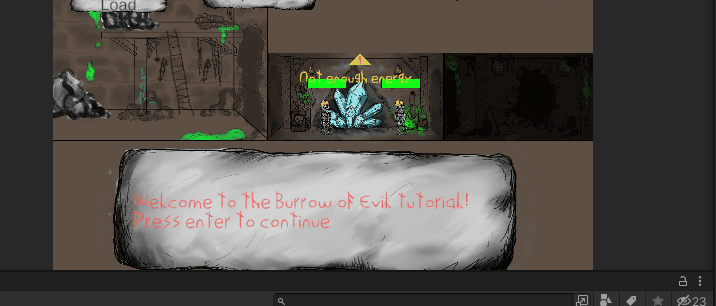Week 6
This is the last week of development before the game will be assessed. Naturally, I focused on making the current game fully playable for the markers. The most important thing was to create a tutorial that explains how to play the game, so that is where I started this week. I added as many quality-of-life features as possible to make the game feel more polished. I also made some significant balance changes.
For the tutorials, I had to try and explain the main mechanics of the game. Those would be camera movement, selecting monsters, sending them to rooms, how the rooms work, and how expeditions work. In the ideal world, I'd like that to be done through a whole other dungeon and tied into a dialogue between monsters and the tutorial could end with a raid that wipes out the tutorial dungeon. In reality, there wasn't enough time to implement it, so I had to settle with making a plain text tutorial. It isn't just a wall of text though. It presents the player with a few sentences of information about the game and then waits for the player to try it out to make sure that they don't accidentally skip past it. Another way I was able to reduce the tutorial by a fair bit was by putting warnings in the game if the player is doing something wrong. For example, if the spawner room is working but there isn't enough resources or space a warning sign will pop up to warn the player about it

The way I implemented the tutorial was quite interesting too. I wanted to be easily able to add or remove tutorial parts, for the parts to have some text, and unique checks. I have created two classes to bring that to life: tutorial manager, and a class I called pop up, which is basically a part of the tutorial. The pop-up class is fairly simple. It obviously has a string variable for text and for the check I made it store a function that is called check. I also added the most basic constructor that asks for the text and the check and assigns it to the new object. The tutorial manager class is quite simple too. It has a list of pop-ups and it stores the current index it is at. It assigns the tutorial panel the text from the current pop up and it waits until the player meets the check of the current pop-up. Once the player does, the current index is incremented. Once the program goes through the whole list, the whole tutorial structure is destroyed as it is no longer needed. This allows for easy addition or removal of parts of the tutorial. The parts are added when the tutorial manager loads.

Another big step that is worth mentioning would be changes to the balance. I initially was simply giving everything values that "felt right". I didn't realise how bad that strategy was before this. It worked for me just fine in my previous projects but only because they were simple platformers. We live, we learn. I have created a new excel document where I keep all of the expedition events and outcomes from them. I have broken them down into time frames and calculated averages for each time frame. I have changed some events to give more food to raise averages for certain time periods. I also reduced the food monsters consume according to my new calculations so that the dungeon can actually be supported. The longer the average time of the expedition is, the more monsters a dungeon may have at a time. This would also be good for making the players run into raids. However, raids are still not implemented.
Also some debugging
Files
Burrow of Evil
| Status | In development |
| Author | ellipsis9 |
| Genre | Strategy |
More posts
- DocumentationOct 16, 2022
- Week 5Oct 09, 2022
- Game TestingOct 04, 2022
- Week 4Oct 02, 2022
- week 3Sep 25, 2022
- Week 2Sep 19, 2022
- Assignment 2Sep 12, 2022
- Week 1 devlogSep 12, 2022
Leave a comment
Log in with itch.io to leave a comment.